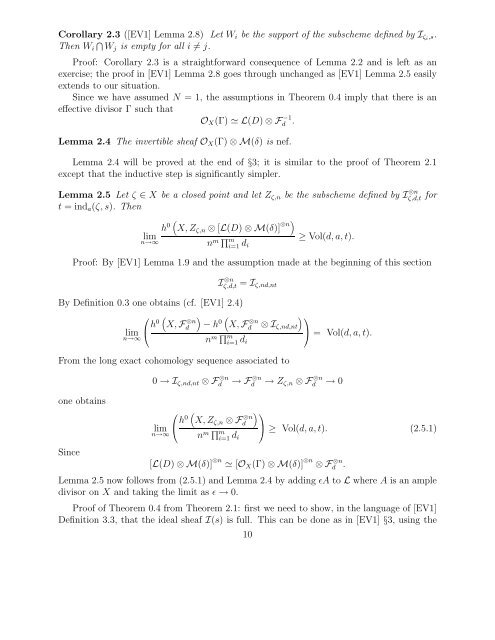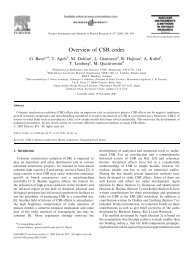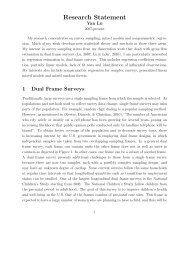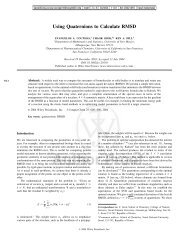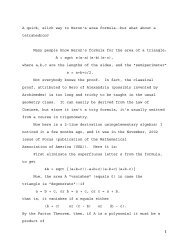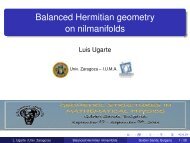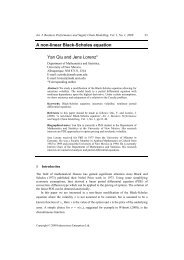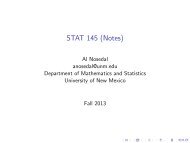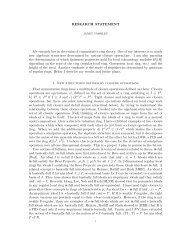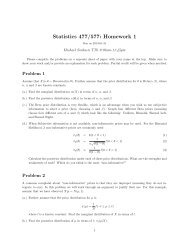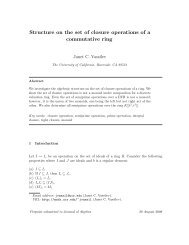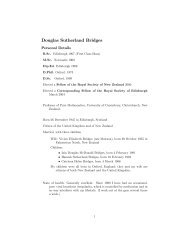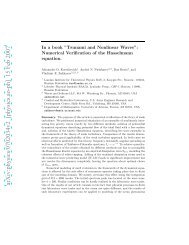Dyson's Lemma and a Theorem of Esnault and Viehweg
Dyson's Lemma and a Theorem of Esnault and Viehweg
Dyson's Lemma and a Theorem of Esnault and Viehweg
Create successful ePaper yourself
Turn your PDF publications into a flip-book with our unique Google optimized e-Paper software.
Corollary 2.3 ([EV1] <strong>Lemma</strong> 2.8) Let W i be the support <strong>of</strong> the subscheme defined by I ζi ,s.Then W i⋂ Wj is empty for all i ≠ j.Pro<strong>of</strong>: Corollary 2.3 is a straightforward consequence <strong>of</strong> <strong>Lemma</strong> 2.2 <strong>and</strong> is left as anexercise; the pro<strong>of</strong> in [EV1] <strong>Lemma</strong> 2.8 goes through unchanged as [EV1] <strong>Lemma</strong> 2.5 easilyextends to our situation.Since we have assumed N = 1, the assumptions in <strong>Theorem</strong> 0.4 imply that there is aneffective divisor Γ such thatO X (Γ) ≃ L(D) ⊗ Fd −1 .<strong>Lemma</strong> 2.4 The invertible sheaf O X (Γ) ⊗ M(δ) is nef.<strong>Lemma</strong> 2.4 will be proved at the end <strong>of</strong> §3; it is similar to the pro<strong>of</strong> <strong>of</strong> <strong>Theorem</strong> 2.1except that the inductive step is significantly simpler.<strong>Lemma</strong> 2.5 Let ζ ∈ X be a closed point <strong>and</strong> let Z ζ,n be the subscheme defined by I ⊗nζ,d,t fort = ind a (ζ, s). Thenh ( 0 X, Z ζ,n ⊗ [L(D) ⊗ M(δ)] ⊗n)limn→∞ n m ∏ m≥ Vol(d, a, t).i=1 d iPro<strong>of</strong>: By [EV1] <strong>Lemma</strong> 1.9 <strong>and</strong> the assumption made at the beginning <strong>of</strong> this sectionBy Definition 0.3 one obtains (cf. [EV1] 2.4)I ⊗nζ,d,t = I ζ,nd,nt⎛ ( )lim ⎝ h0 X, F ( )d⊗n − h0X, Fd ⊗n ⎞⊗ I ζ,nd,ntn→∞n m ∏ ⎠m= Vol(d, a, t).i=1 d iFrom the long exact cohomology sequence associated toone obtainsSince0 → I ζ,nd,nt ⊗ F ⊗nd→ F ⊗nd→ Z ζ,n ⊗ F ⊗nd → 0⎛ ( )lim ⎝ h0 X, Z ζ,n ⊗ Fd⊗n ⎞n→∞ n m ∏ ⎠m≥ Vol(d, a, t). (2.5.1)i=1 d i[L(D) ⊗ M(δ)] ⊗n ≃ [O X (Γ) ⊗ M(δ)] ⊗n ⊗ F ⊗nd .<strong>Lemma</strong> 2.5 now follows from (2.5.1) <strong>and</strong> <strong>Lemma</strong> 2.4 by adding ǫA to L where A is an ampledivisor on X <strong>and</strong> taking the limit as ǫ → 0.Pro<strong>of</strong> <strong>of</strong> <strong>Theorem</strong> 0.4 from <strong>Theorem</strong> 2.1: first we need to show, in the language <strong>of</strong> [EV1]Definition 3.3, that the ideal sheaf I(s) is full. This can be done as in [EV1] §3, using the10


